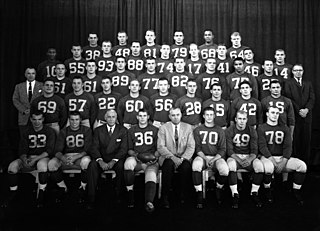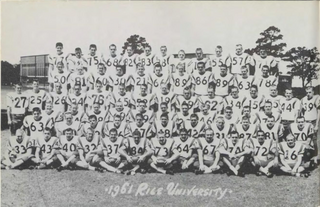Related Research Articles
The 1961 Florida Gators football team was an American football team that represented the University of Florida as a member of the Southeastern Conference (SEC) during the 1961 college football season. In their second year under head coach Ray Graves, the Gators compiled a 4–5–1 record, finished in sixth place in the SEC, and outscored opponents by a total of 146 to 97.
The 1961 Minnesota Golden Gophers football team was an American football team that represented the University of Minnesota in the 1961 Big Ten Conference football season. In their eighth year under head coach Murray Warmath, the Golden Gophers compiled an 8–2 record, outscored opponents by a total of 140 to 75, and were ranked No. 6 in the final final AP and UPI polls. They defeated UCLA, 21–3, in the 1962 Rose Bowl.

The 1966 Michigan Wolverines football team represented the University of Michigan in the 1966 Big Ten Conference football season. In its eighth year under head coach Bump Elliott, Michigan compiled a 6–4 record, tied for third place in the Big Ten, and outscored opponents by a combined total of 236 to 138.

The 1962 Michigan Wolverines football team was an American football team that represented the University of Michigan in the 1962 Big Ten Conference football season. In its fourth year under head coach Bump Elliott, Michigan compiled a 2–7 record, finished in last place in the Big Ten, and were outscored by opponents by a combined total of 214 to 70.

The 1959 Michigan Wolverines football team was an American football team that represented the University of Michigan in the 1959 Big Ten Conference football season. In its first year under head coach Bump Elliott, Michigan compiled a 4–5 record, finished in seventh place in the Big Ten, and was outscored by a combined total of 161 to 122.

The 1958 Michigan Wolverines football team represented the University of Michigan in the 1958 Big Ten Conference football season. In its 11th and final year under head coach Bennie Oosterbaan, Michigan compiled a 2–6–1 record, finished in eighth place in the Big Ten, and were outscored by opponents by a combined total of 211 to 132 points.

The 1954 Michigan Wolverines football team represented the University of Michigan in the 1954 Big Ten Conference football season. In its seventh year under head coach Bennie Oosterbaan, Michigan compiled a 6–3 record, tied for second place in the Big Ten, outscored opponents by a combined total of 139 to 87, and was ranked No. 15 in the final AP and Coaches Polls.

The 1953 Michigan Wolverines football team represented the University of Michigan in the 1953 Big Ten Conference football season. In its sixth year under head coach Bennie Oosterbaan, Michigan compiled a 6–3 record, tied for fifth place in the Big Ten, outscored opponents by a combined total of 163 to 101, and was ranked No. 20 in the final AP Poll and No. 19 in the Coaches Polls.

The 1952 Michigan Wolverines football team represented the University of Michigan in the 1952 Big Ten Conference football season. In its fifth year under head coach Bennie Oosterbaan, Michigan compiled a 5–4 record, tied for fourth place in the Big Ten, and outscored opponents by a combined total of 207 to 134. For the second consecutive season, Michigan was not ranked in the final AP Poll; it was ranked at No. 17 in the final Litkenhous Ratings.

The 1951 Michigan Wolverines football team was an American football team that represented the University of Michigan in the 1951 Big Ten Conference football season. In its fourth year under head coach Bennie Oosterbaan, Michigan compiled a 4–5 record, finished in fourth place in the Big Ten, and outscored opponents by a combined total of 135 to 122. For the first time since 1937, Michigan was not ranked in the final AP Poll. It was ranked at No. 29 in the final Litkenhous Ratings.
The 1952 USC Trojans football team represented the University of Southern California (USC) in the 1952 college football season. In their second year under head coach Jess Hill, the Trojans compiled a 10–1 record, won the Pacific Coast Conference championship, and outscored their opponents by a combined total of 254 to 47.
The 1961 Tennessee Volunteers football team was an American football team that represented the University of Tennessee as a member of the Southeastern Conference (SEC) during the 1961 college football season. In their seventh year under head coach Bowden Wyatt, the team compiled a 6–4 record. tied for fourth place in the SEC, and outscored opponents by a total of 221 to 149.

The 1961 Purdue Boilermakers football team was an American football team that represented Purdue University during the 1961 Big Ten Conference football season. In their sixth year under head coach Jack Mollenkopf, the Boilermakers compiled a 6–3 record, finished fourth in the Big Ten, and outscored opponents by a total of 146 to 87. They were ranked No. 11 in the final UPI poll and No. 12 in the final AP poll.
The 1961 Tampa Spartans football team was an American football team that represented the University of Tampa as an independent during the 1961 college football season. In their 25th season of college football and their 10th season under head coach Marcelino Huerta, the Spartans compiled an 8–1 record and outscored opponents by a total of 188 to 98.
The 1961 Oklahoma Sooners football team was an American football team that represented the University of Oklahoma as a member of the Big Eight Conference during the 1961 college football season. In their 15th year under head coach Bud Wilkinson, the Sooners compiled a 5–5 record, finished in fourth place in the Big 8, and were outscored by a total of 141 to 122. The Sooners lost the first five games of the season before turning things around with five consecutive wins, including a victory over No. 10 Missouri, to finish the season. The 1960 and 1961 seasons were the only non-winning seasons in Wilkinson's 17-year tenure as Oklahoma's head coach.
The 1961 Duke Blue Devils football team was an American football team that represented Duke University as a member of the Atlantic Coast Conference (ACC) during the 1961 college football season. In their eleventh year under head coach Bill Murray, the Blue Devils compiled a 7–3 record, won the ACC championship, and outscored opponents by a total of 183 to 106. In non-conference games, they defeated Navy and Notre Dame but lost to Georgia Tech and Michigan. They were ranked No. 14 in the final UPI coaches poll and No. 20 in the final AP writers poll.

The 1961 Virginia Cavaliers football team was an American football team that represented the University of Virginia as a member of the Atlantic Coast Conference (ACC) during the 1961 college football season. In their first year under head coach Bill Elias, the Cavaliers compiled a 4–6 record, were outscored by a total of 190 to 123, and finished in eighth place out of eight teams in the ACC. Despite the last place finish, Elias was named ACC Coach of the Year, becoming the second in conference history to win the award in a coach's first year at the school. Elias, who had been the Southern Conference Coach of the Year the previous season at George Washington, snapped Virginia's 28-game losing streak by beating William & Mary in the first game of the season. Their win against South Carolina snapped an 18-game losing streak against ACC foes.

The 1961 Rice Owls football team was an American football team that represented Rice University as a member of the Southwest Conference (SWC) during the 1961 college football season. In their 22nd year under head coach Jess Neely, the Owls compiled a 7–3 record, finished in third place in the SWC, and outscored opponents by a total of 176 to 125. They concluded their season with a 33–7 loss to Kansas in the 1961 Bluebonnet Bowl
The 1969 Little All-America college football team is composed of college football players from small colleges and universities who were selected by the Associated Press (AP) as the best players at each position. For 1969, the AP selected two teams, each team having separate offensive and defensive platoons.
The 1970 Westminster Titans football team was an American football team that won the NAIA Division II football national championship. They represented Westminster College, a small college in New Wilmington, Pennsylvania, with a total enrollment of 1,558 students, competing against other "small" colleges like Texas A&I with enrollments as high as 21,000. The Titans competed as an independent during the 1970 NAIA Division II football season. In their 19th season under head coach Harold Burry, the Titans compiled a perfect 10–0 record and outscored opponents by a total of 284 to 62. Burry was inducted into the College Football Hall of Fame in 1996.
References
- ↑ "Fitzgerald, All-American: Back to Work for 'Gades; Only Jaysee Player on All Eleven". The Bakersfield Californian. December 2, 1953. p. 37 – via Newspapers.com.
- ↑ "This Page's Rose Aroma No Accident". The Bakersfield Californian. November 30, 1963. p. 1 – via Newspapers.com.
- ↑ "City Council Proclaims Renegade Day". The Bakersfield Californian. December 8, 1953. p. 21 – via Newspapers.com.
- ↑ "Tomorrow Is J.R.B. Day for Bakersfield: Mass Exodus Is Under Way". The Bakersfield Californian. December 11, 1953. p. 36 – via Newspapers.com.
- ↑ "SC Mustangs Defeated by Bakersfield". Stockton Record. September 19, 1953. p. 24 – via Newspapers.com.
- ↑ Bruce Farris (October 4, 1953). "Unbeaten Bakersfield JC Drops Rams, 16-14". The Fresno Bee. p. 5B – via Newspapers.com.
- ↑ "Bakersfield's Power Smashes Seahawks, 41-0". San Pedro News-Pilot. October 17, 1953. p. 12 – via Newspapers.com.
- ↑ "Bulldog, Renegade Elevens Triumph". Los Angeles Times. November 14, 1953. p. III-2 – via Newspapers.com.
- ↑ Walt Little (November 21, 1953). "'Gades, Monarchs to Clash: League's Crown Is a Stake". The Bakersield Californian. p. 1 – via Newspapers.com.
- ↑ Walt Little (November 27, 1953). "Bowl-Minded Renegades Place Record on Line Tonight at Taft". The Bakersfield Californian. p. 1 – via Newspapers.com.
- ↑ Walt Little (November 28, 1953). "Galloping Gades Await Pasadena Voting: Renegades Undefeated as Taft Bows". The Bakersfield Californian. p. 18 – via Newspapers.com.
- ↑ "'Gades Picked for Rose Bowl:: Face Miami, Okla., Team". The Bakersfield Californian. November 30, 1963. p. 1 – via Newspapers.com.
- ↑ Walt Little (December 14, 1953). "Bakersfield Rules JC Grid World: Line Leads Way as Gades Drop Oklahoma Team". The Bakersfied Californian. p. 37 – via Newspapers.com.
- ↑ "How They'll Line Up for Rose Classic". The Bakersield Californian. December 11, 1953. p. 37 – via Newspapers.com.